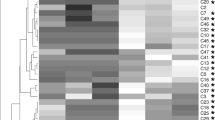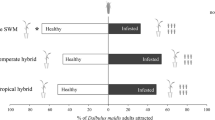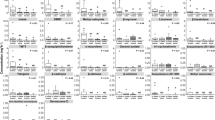Abstract
Like most phytophagous insect pests, wireworms are suspected to use plant volatile organic compounds (VOCs) to locate appropriate host plants. Preliminary field observations at our study site showed strong differences in the infestation level of four varieties of maize by wireworms. We raised and tested the hypothesis that these maize varieties have differential susceptibility/attraction to wireworms because they emit different VOCs from their roots. We collected, separated, identified and quantified VOCs from the roots of two maize varieties having experienced contrasted levels of wireworm infestation in the field. We showed that the less susceptible variety released a more diverse blend of VOCs, including large amounts of hexanal, heptanal and 2,3-octenanedione. The higher diversity and concentration of VOCs could play a role on the pest repulsion, explaining the difference in susceptibility of variety with respect to the other one. Laboratory dual-choice bioassays showed that wireworms were strongly attracted to COV released by maize roots. However, when wireworms were offered both maize varieties, no preference was detected, contrasting with the field results. Therefore, VOCs may not be the only cues influencing host selection by wireworms.






Similar content being viewed by others
References
Ballhorn DJ, Kautz S, Schädler M (2013) Induced plant defense via volatile production is dependent on rhizobial symbiosis. Oecologia 172(3):833–846
Barsics F, Haubruge E, Verheggen F (2013) Wireworms’ management: an overview of the existing methods, with particular regards to Agriotes spp. (Coleoptera: Elateridae). Insects 4(1):117–152
Barsics F, Delory BM, Delaplace P, Francis F, Fauconnier ML, Haubruge E, Verheggen FJ (2017) Foraging wireworms are attracted to root-produced volatile aldehydes. J Pest Sci 90(1):69–76
Brandl MA, Schumann M, Przyklenk M, Patel A, Vidal S (2017) Wireworm damage reduction in potatoes with an attract-and-kill strategy using Metarhizium brunneum. J Pest Sci 90(2):479–493
Bruce TJ, Wadhams LJ, Woodcock CM (2005) Insect host location: a volatile situation. Trends Plant Sci 10(6):269–274
Carroll MJ, Schmelz EA, Meagher RL, Teal PE (2006) Attraction of Spodoptera frugiperda larvae to volatiles from herbivore-damaged maize seedlings. J Chem Ecol 32(9):1911–1924
Chiriboga X, Guo H, Campos-Herrera R, Röder G, Imperiali N, Keel C, Maurhofer M, Turlings TC (2018) Root-colonizing bacteria enhance the levels of (E)-β-caryophyllene produced by maize roots in response to rootworm feeding. Oecologia 187(2):459–468
Cocquempot C, Martinez M, Courbon R, Blanchet A, Caruhel P (1999) Nouvelles données sur l’identification des larves de taupins (Coleoptera: Elateridae): une aide à la connaissance biologique et à la cartographie des espèces nuisibles. In: Proceedings of ANPP-5ème conférence internationale sur les ravageurs en agriculture, Montpellier, France, pp 477–486
De Moraes CM, Mescher MC, Tumlinson JH (2001) Caterpillar-induced nocturnal plant volatiles repel conspecific females. Nature 410:577–580
Delory BM, Delaplace P, Fauconnier ML, Du Jardin P (2016) Root-emitted volatile organic compounds: can they mediate belowground plant–plant interactions? Plant Soil 402(1–2):1–26
Dicke M, Baldwin IT (2010) The evolutionary context for herbivore-induced plant volatiles: beyond the ‘cry for help’. Trends Plant Sci 15(3):167–175
Doane JF, Klingler J (1978) Location of CO2-receptive sensilla on larvae of the wireworms Agriotes lineatus-obscurus and Limonius californicus. Ann Entomol Soc Am 71(3):357–363
Doane JF, Lee YW, Westcott ND, Klingler J (1975) The orientation response of Ctenicera destructor and other wireworms (Coleoptera: Elateridae) to germinating grain and to carbon dioxide. Can Entomol 107:1233–1252
Erb M, Robert CA, Hibbard BE, Turlings TC (2011) Sequence of arrival determines plant-mediated interactions between herbivores. J Ecol 99(1):7–15
Farag MA, Fokar M, Abd H, Zhang H, Allen RD, Pare PW (2005) (Z)-3-Hexenol induces defense genes and downstream metabolites in maize. Planta 220(6):900–909
Food and Agriculture Organization of the United Nations (FAO). FAOSTAT database from http://faostat3.fao.org/home/E. Accessed 27 June 2018
Furlan L (2004) The biology of Agriotes sordidus Illiger (Col., Elateridae). J Appl Entomol 128(9–10):696–706
Furlan L (2014) IPM thresholds for Agriotes wireworm species in maize in Southern Europe. J Pest Sci 87(4):609–617
Gfeller A, Laloux M, Barsics F, Kati DE, Haubruge E, Du Jardin P, Verheggen F, Lognay G, Whatelet JP, Fauconnier ML (2013) Characterization of volatile organic compounds emitted by barley (Hordeum vulgare L.) roots and their attractiveness to wireworms. J Chem Ecol 39(8):1129–1139
Gouinguené S, Pickett JA, Wadhams LJ, Birkett MA, Turlings TC (2005) Antennal electrophysiological responses of three parasitic wasps to caterpillar-induced volatiles from maize (Zea mays mays), cotton (Gossypium herbaceum), and cowpea (Vigna unguiculata). J Chem Ecol 31(5):1023–1038
Gregg PC, Del Socorro AP, Landolt PJ (2018) Advances in attract-and-kill for agricultural pests: beyond pheromones. Annu Rev Entomol 63:453–470
Heil M (2014) Herbivore-induced plant volatiles: targets, perception and unanswered questions. New Phytol 204:297–306
Hermann A, Brunner N, Hann P, Wrbka T, Kromp B (2013) Correlations between wireworm damages in potato fields and landscape structure at different scales. J Pest Sci 86:33–39
Hibbard BE, Duran DP, Ellersieck MR, Ellsbury MM (2003) Post-establishment movement of western corn rootworm larvae (Coleoptera: Chrysomelidae) in Central Missouri corn. J Econ Entomol 96:599–608
Hiltpold I, Turlings TC (2008) Belowground chemical signaling in maize: when simplicity rhymes with efficiency. J Chem Ecol 34(5):628–635
Hiltpold I, Erb M, Robert CAM, Turlings TCJ (2011) Systemic root signalling in a belowground, volatile-mediated tritrophic interaction. Plant Cell Environ 34:1267–1275. https://doi.org/10.1111/j.1365-3040.2011.02327.x
Jactel H, Verheggen F, Thiéry D, Escobar-Gutiérrez AJ, Gachet E, Desneux N, Neonicotinoids Working Group (2019) Alternatives to neonicotinoids. Environ Int 129:423–429
Johnson SC, Gregory PJ (2006) Chemically-mediated host plant location and selection by root-feeding insects. Physiol Entomol 31:1–13
Johnson SN, Nielsen UN (2012) Foraging in the dark—chemically mediated host plant location by belowground insect herbivores. J Chem Ecol 38:604–614
Johnson SN, Hallett PD, Gillespie TL, Halpin C (2010) Below-ground herbivory and root toughness: a potential model system using lignin-modified tobacco. Physiol Entomol 35(2):186–191
Klingler J (1957) Über die Bedeutung des Kohlendioxyds für die Orientierung der Larven von Otiorrhynchus sulcatus F., Melolontha und Agriotes (Col.) im Boden (Vorläufige Mitteilung). Mitt. Schweiz Entom Ges 30:317–322
la Forgia D, Verheggen F (2017) The law of attraction: identification of volatiles organic compounds emitted by potatoes as wireworms attractants. Commun Agric Appl Biol Sci 82(2):167–169
la Forgia D, Verheggen F (2019) Biological alternatives to pesticides to control wireworms. Aggene 11:100080
Maag D, Dalvit C, Thevenet D, Köhler A, Wouters FC, Vassão DG, Gershenzond J, Wolfendere JC, Turlings TJC, Erb M, Glauser G (2014) 3-β-D-Glucopyranosyl-6-methoxy-2-benzoxazolinone (MBOA-N-Glc) is an insect detoxification product of maize 1, 4-benzoxazin-3-ones. Phytochemistry 102:97–105
Maga JA (1981) Mushroom flavor. J Agric Food Chem 29(1):1–4
Perry LG, Alford ER, Horiuchi J, Paschke MW, Vivanco JM (2007) Chemical signals in the rhizosphere: root–root and root–microbe communication. In: Pinton R, Varanini Z, Nannipieri P (eds) The rhizosphere: biochemistry and organic substances at the soil–plant interface. CRC Press, Boca Raton, pp 297–330
Rasmann S, Bauerle TL, Poveda K, Vannette R (2011) Predicting root defence against herbivores during succession. Funct Ecol 25(2):368–379
Robert CA, Erb M, Duployer M, Zwahlen C, Doyen GR, Turlings TC (2012) Herbivore-induced plant volatiles mediate host selection by a root herbivore. New Phytol 194(4):1061–1069
Schumann M, Ladin ZS, Beatens JM, Hiltpold I (2018) Navigating on a chemical radar: usage of root exudates by foraging Diabrotica virgifera virgifera larvae. J Appl Entomol 142:911–920
Shelton AM, Badenes-Perez FR (2006) Concepts and applications of trap cropping in pest management. Annu Rev Entomol 51:285–308
Splivallo R, Novero M, Bertea CM, Bossi S, Bonfante P (2007) Truffle volatiles inhibit growth and induce an oxidative burst in Arabidopsis thaliana. New Phytol 175(3):417–424
Traugott M, Benefer CM, Blackshaw RP, van Herk WG, Vernon RS (2015) Biology, ecology, and control of elaterid beetles in agricultural land. Annu Rev Entomol 60:313–334
Van Dam NM, Bouwmeester HJ (2016) Metabolomics in the rhizosphere: tapping into belowground chemical communication. Trends Plant Sci 21(3):256–265
Van Herk WG, Vernon RS (2014) Soil bioassay for studying behavioral responses of wireworms (Coleoptera: Elateridae) to insecticide-treated wheat seed. Environ Entomol 36(6):1441–1449
Van Herk WG, Vernon RS, Vojtko B, Snow S, Fortier J, Fortin C (2015) Contact behaviour and mortality of wireworms exposed to six classes of insecticide applied to wheat seed. J Pest Sci 88(4):717–739
Vernon RS (2005) Aggregation and mortality of Agriotes obscurus (Coleoptera: Elateridae) at insecticide-treated trap crops of wheat. J Econ Ent 98:1999–2005
Vernon RS, Kabaluk T, Behringer A (2000) Movement of Agriotes obscurus (Coleoptera: Elateridae) in strawberry (Rosaceae) plantings with wheat (Gramineae) as a trap crop. Can Entomol 132(2):231–241
Vernon RS, van Herk WG, Clodius M, Tolman J (2016) Companion planting attract-and-kill method for wireworm management in potatoes. J Pest Sci 89(2):375–389
Veyrat N, Robert CAM, Turlings TCJ, Erb M (2016) Herbivore intoxication as a potential primary function of an inducible volatile plant signal. J Ecol 104(2):591–600
Zeng SR (2014) Allelopathy—the solution is indirect. J Chem Ecol 40:515–516. https://doi.org/10.1007/s10886-014-0464-7
Acknowledgements
D. la Forgia is supported by a Ph.D. Grant from Coordinated Integrated Pest Management in Europe (C-IPM), project ElatPro. The authors thank Mickaël Gaillard for scientific support, and Rhoxane Schelkens and Shannon Thiery for technical assistance. We thank the anonymous reviewers for their constructive comments that helped improve this manuscript.
Funding
This study was funded by a Coordinated Integrated Pest Management in Europe (C-IPM) project, called ElatPro.
Author information
Authors and Affiliations
Corresponding author
Ethics declarations
Conflict of interest
All authors declare that they have no conflict of interest.
Ethical approval
All applicable international, national and/or institutional guidelines for the care and use of animals were followed. Just invertebrates (insects) were used.
Additional information
Communicated by C. M. Benefer.
Publisher's Note
Springer Nature remains neutral with regard to jurisdictional claims in published maps and institutional affiliations.
Rights and permissions
About this article
Cite this article
la Forgia, D., Thibord, JB., Larroudé, P. et al. Linking variety-dependent root volatile organic compounds in maize with differential infestation by wireworms. J Pest Sci 93, 605–614 (2020). https://doi.org/10.1007/s10340-019-01190-w
Received:
Revised:
Accepted:
Published:
Issue Date:
DOI: https://doi.org/10.1007/s10340-019-01190-w




